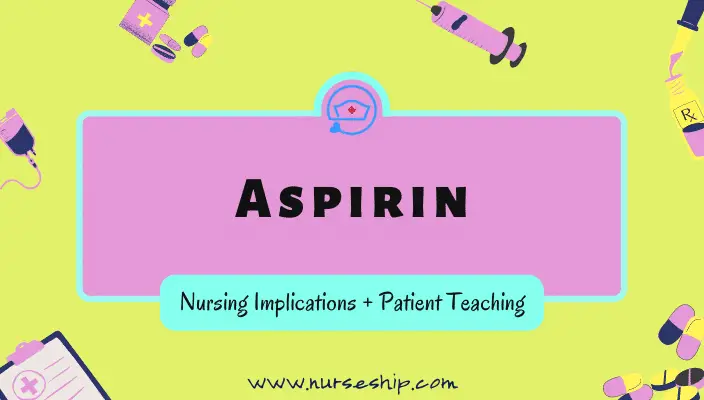Last updated on December 28th, 2023
Introduction
This post will teach you about aspirin nursing considerations and patient education. You’ll also learn so much more about aspirin, such as its mechanism of action, indications, contraindications, side effects, and so on.
Aspirin is a first-generation NSAIDs Salicylates. It belongs to the salicylate family, a derivate of salicylic acid. Aspirin is also known as acetylsalicylic acid (ASA), after the acetyl group used in its formulation. Aspirin is commonly abbreviated as ASA.
Aspirin’s four main therapeutic actions are pain relief, relief of inflammatory symptoms, body temperature reduction, and inhibition of platelet aggregation.
Generic Name: Aspirin
Brand Names: A.S.A, Bayer, Ecotrin, Astrin, Acuprin, Ascriptin Enteric, Aspergum, Aspir-Low, Aspir-trin, Bayer Aspirin, Easprin, Halfprin, Aspir-81, Durlaza, Genprin, Miniprin, Norwich, Sloprin, Zorpin, Asaphen (CAN), Asatab (CAN), Atria S.R. (CAN), Entrophen (CAN), Lowprin (CAN), Novasen (CAN), Rivasa (CAN), Sal-Adult (CAN), Sal-Infant (CAN), Supasa (CAN),
Aspirin Class and Category
Pharmacologic class: First-Generations NSAIDs Salicylates
Therapeutic class: NSAIDs (anti-inflammatory, anti-platelet, anti-pyretic, nonopioid analgesic)
Pregnancy category: D
Aspirin Dosage
Analgesia, Hyperpyrexia
Adult: PO: 325-650 mg q4h PRN; max: 4 g/day
Child: PO: 10-15 mg/kg/day in 4 to 6 divided doses; max: 4 g/day
TIA, Acute Ml, Chronic Stable/Unstable Angina, Revascularization Procedures, Prevent Reinfarction and Thromboembolism Post Ml
Adult: PO: 80-325 mg/day
Arthritis, Osteoarthritis, and Other inflammatory conditions
Adult: PO: 3 g/day in divided doses (Salicylate target range: 15-30 mg/dL or 150 to 300 mcg/mL)
Juvenile RA
Children: PO/RECT 90-130 mg/kg/day in divided doses (Salicylate target range: 15-30 mg/dL or 150 to 300 mcg/mL)
Kawasaki’s Disease
Children: PO: 80–100 mg/kg/day in divided doses.
Aspirin Pharmacokinetics and Pharmacodynamics
| Route | Onset | Peak | Duration |
| PO | 15-30 min | 1-2 hr | 4-6 hr |
| PO (controlled- release) | 5–30 min | 1–4 hr | 4–6 hr |
| PO (enteric-coated) | 10–30 min | Unknown | 2-4 hr |
| PR | Slow | Unknown | 4–6 hr |
Absorption: Aspirin is effectively absorbed from the GI tract when taken orally. PO absorption ranges between 80% and 100%.
Distribution: It crosses the placenta and excretes in breast milk.
Metabolism: Hepatic.
Half-life: For low doses 15-20 minutes and up to 30 hours for high doses.
Excretion: The kidneys eliminate inactive substances through urine.

Human Anatomy & Physiology Course
- Guidebooks
- Complete Diagrams & Lessons
- Certifications
- Quiz & Answers
- And More…
Aspirin mechanism of action
The enzyme cyclooxygenase, which is required for prostaglandin synthesis, is blocked.
Prostaglandins, which play a crucial role in the inflammatory response, produce local vasodilation, edema, and pain. Inflammatory symptoms are reduced by inhibiting prostaglandins and blocking cyclooxygenase.
Pain is also alleviated because prostaglandins play a role in pain transmission from the periphery to the spinal cord.
Aspirin suppresses platelet aggregation by inhibiting the formation of thromboxane A2, which stimulates platelet aggregation.
Aspirin works on the hypothalamic heat-regulating center, causing peripheral vasodilation, diaphoresis, and heat loss.
What are the indications of aspirin?
Aspirin indications include:
- To alleviate mild pain or fever.
- To alleviate mild to moderate pain caused by inflammation, such as in rheumatoid arthritis, osteoarthritis, or juvenile rheumatoid arthritis.
- To lower the risk of repeated transient ischemic episodes or ischemic stroke.
- To lessen the severity of acute MI or to prevent it.
- To reduce the risk of MI in patients who have had a previous MI or unstable angina.
- To lower the risk of death and recurrent stroke in patients who have experienced an ischemic stroke or transient ischemic attack.
- To lower the risk of death and MI in patients who have chronic coronary artery disease.
- Prophylactic therapy for coronary artery bypass graft and percutaneous transluminal coronary angioplasty (PTCA).
- To get the patient ready for a carotid endarterectomy.
- As a treatment for spondyloarthropathies.
What are the contraindications of aspirin?
The contraindications of aspirin are:
- History of hypersensitivity to salicylates or NSAIDs.
- Active bleeding, coagulation disorders or currently on anticoagulant therapy
- History of current or recent GI bleeding or ulcers
- Bone marrow suppression
- Flu or viral symptoms in children since it can lead to the life-threatening Reye syndrome.
- During third trimester of pregnancy Because it may cause the ductus arteriosus in the fetus to close prematurely
Caution: Renal or hepatic disorders gout, alcoholism
Aspirin Interactions
Drug: Anticoagulants and other NSAIDs increase the risk of bleeding; oral hypoglycemic medications increase the risk of hypoglycemia, and glucocorticoids have an ulcerogenic effect.
Lab: Reduce cholesterol and potassium levels, as well as T3, T4 levels; increases PT, bleeding time, uric acid levels, amylase, CO2, LFTs, and urinary protein
What are aspirin side effects?
Aspirin side effects / adverse reactions include:
- Anorexia
- Nausea and vomiting
- Diarrhea
- Dizziness and drowsiness
- Confusion
- Hearing loss
- Heartburn
- Rash
- Abdominal pain
- Tinnitus
- Urticaria
- Ulceration
- GI bleeding
- Life-threatening adverse effects: Agranulocytosis, hemolytic anemia, bronchospasm, anaphylaxis, thrombocytopenia, Reye’s syndrome, hepatotoxicity, leukopenia
How does aspirin affect homeostasis?
Aspirin can help prevent cardiovascular events in high-risk individuals. The primary recognized effect of aspirin on hemostasis is to reduce thrombus formation on the surface of the injured artery wall by inhibiting platelet thromboxane A2 production.
Aspirin Nursing Considerations [Nursing implications]
Aspirin nursing considerations are divided into nursing assessment, interventions, and evaluation.
Nursing Assessment:
- Obtain medical and drug history such as history of GI bleeding or ulcers, hypersensitivity, OTC drug use, possible drug-drug interaction and so on.
- Examine the nature, location, duration, of the inflammation and the pain. Check the affected joints for immobility, deformity, and skin condition.
Nursing Interventions/ Actions
- Do not administer aspirin to children or teenagers who have or have recently had viral infections (since it raises the risk of Reye’s syndrome).
- When aspirin given as antipyretic, monitor body temperature both before and one hour after giving medicine.
- Monitor urine pH (rapid acidification may indicate toxicity).
- Check for signs of bleeding such as dark (tarry) stools, bleeding gums, petechiae (round red spots), ecchymosis (excessive bruising), and purpura (large red spots), when a patient takes a high dose of aspirin
- Monitor serum salicylate (aspirin) level when a patient is taking large dosages of aspirin for chronic illnesses such as arthritis. The therapeutic blood level for antiarthritic action is 15-30 mg/dL (150 to 300 mcg/mL). Mild toxicity occurs when serum levels exceed 30 mg/dL, while severe toxicity occurs when serum levels exceed 50 mg/dL.
- Monitor CBC, Hct, PT, renal function and liver function when patient is undergoing long-term therapy.
- Closely observe for signs of hepatotoxicity (eg; dark urine, clay-colored stools, yellowing of skin, sclera, itching, abdominal pain, fever, diarrhea)
- Observe for signs of hypersensitivity to aspirin such as rash, itching.
- Observe for signs of ototoxicity such as tinnitus, ringing, roaring in ears.
- When a rapid onset of action is required, such as in the acute treatment of a myocardial infarction or before undergoing percutaneous coronary intervention (PCI), use an immediate-release aspirin.
Pregnancy/breastfeeding Considerations
- The drug may cause fetal harm, particularly in the third trimester, by causing premature closure of the ductus arteriosus in the fetus.
- Salicylates have been linked to changes in maternal and neonatal hemostasis mechanisms, lower birth weight, and perinatal mortality.
- The drug is generally not advised to be used during pregnancy. In some cases, low-dose aspirin (60 to 100 mg daily) may be used to treat clotting disorders, repeated pregnancy loss, or preeclampsia.
- Because aspirin is present in breast milk, breastfeeding should be avoided.
- In case if mother is required to take low-dose aspirin, the infant should be closely monitored for bleeding and bruising.
- Because of the risk of excessive blood loss during delivery, the drug should not be used one week before and during labor and delivery. Labor may also be prolonged as a result of the drug.
Evaluation
- Evaluate therapeutic response such as reduced pain, inflammation, and fever, joint mobility, serum salicylate level, etc.
- Determine whether the patient has any aspirin side effects.
What is the patient teaching for aspirin?
Following are the important points which should include in aspirin patient teaching.
General patient teaching
- Advise unless otherwise directed by your doctor, DO NOT crush timed-release or controlled-release aspirin tablets.
- Educate the patient that aspirin should not be taken with alcohol or with drugs that are highly protein-bound, such as the anticoagulant warfarin (Coumadin). Because it may result in increased anticoagulant levels.
- Recommend that the patient notify the dentist ahead of time if they are taking high doses of aspirin.
- Advise the patient to stop taking aspirin 3 to 7 days before surgery to reduce the risk of bleeding (with the approval of the health care provider).
- MUST keep the aspirin bottle out of the reach of children.
- Teach parents to contact a poison control center right away if their child consumes a large or unknown amount of aspirin (or acetaminophen).
- WARN the patient that aspirin should not be used to treat viral or flu symptoms in children. Aspirin and viral infections have been linked to Reye’s syndrome.
- Tell the patient that aspirin tablets can cause gastrointestinal upset.
- Teach the patient to discard the tablets if vinegar-like smell is detected. This indicates breakdown of chemical compounds.
- Educate the patient not to exceed recommended dose. It may cause acute poisoning.
- Instruct to refrigerate the suppository for at least 30 minutes before removing the wrapper.
- Inform the patient that anticoagulants, when combined with aspirin, can increase the risk of bleeding. Diabetes medications taken orally may increase the risk of hypoglycemia.
- Tell the patient that the therapeutic response may take two weeks for diseases like arthritis.
- Teach the patient who is allergic to tartrazine not to take aspirin.
- Educate the patient that he or she should consult a doctor before taking aspirin with any prescription medication for a blood disorder, diabetes, gout, or arthritis.
- Teach the patient who has been prescribed Durlaza to swallow the capsule whole with a full glass of water at the same time every day.
Patient teaching about aspirin’s side effects
- Teach the patient to report any side effects such as drowsiness, ear ringing, headaches, flushing, drowsiness, confusion, dizziness, visual changes, and seizures, GI symptoms such as bleeding, bloody or tarry stools, and coughing up blood or vomit that looks like coffee grounds.
- Teach the patient to avoid OTC medicine which contain aspirin (salicylates) to prevent overdose.
Patient teaching about diet
- Educate the patient to take aspirin with food/meal and to drink plenty of fluids to minimizes GI upset.
- Emphasis the risks of alcohol consumption while on aspirin.
Treatment of Aspirin Overdose
- Gastric lavage.
- Monitor vital signs, electrolytes, LFT, RTF, and salicylate levels.
- Administer Vitamin-K as prescribed.
Conclusion
You learned about aspirin nursing considerations and patient teaching in this article. In addition, you’ve learned about aspirin’s mechanism of action, pharmacokinetics, dosage, indications, contraindications, and side effects.
Recommended Readings & Reference
Kee, J., Hayes, E., & McCuistion, L. (2015). PHARMACOLOGY A Patient-Centered Nursing Process Approach (8th ed.). Elsevier Inc/Saunders.
Kizior, R., & Hodgson, K. (2021). SAUNDERS NURSING DRUG HANDBOOK 2021. Elsevier Inc.
Jones & Bartlett Learning. (2021). Nurse’s Drug Handbook (20th ed.). Jones & Bartlett Learning, LLC.
Skidmore-Roth, L. (2021). MOSBY’S 2021 NURSING DRUG REFERENCE (34th ed.). Elsevier Inc.


